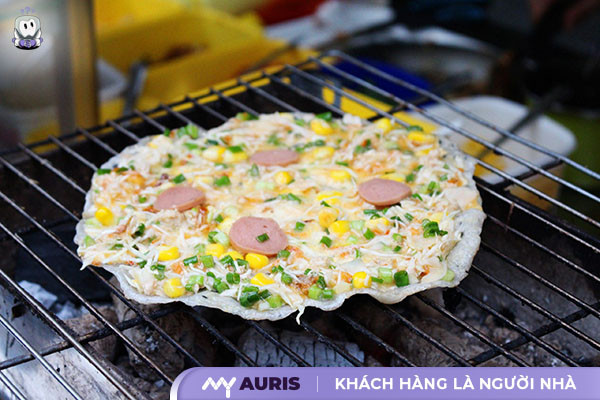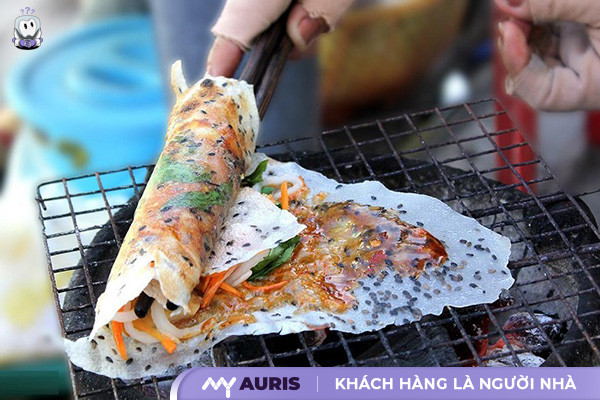This is a question many people are interested in, especially those on a diet or monitoring their daily calorie intake. A dish deeply associated with the childhood and daily life of Vietnamese people, bánh tráng (rice paper) is often used to wrap spring rolls, make fried spring rolls (chả giò), or prepared as an attractive snack. However, not everyone fully understands the nutritional composition and energy content of each piece of bánh tráng. If you’re wondering how many calories are in bánh tráng, the article below will provide detailed, reliable information from a professional perspective, helping you understand better to choose foods suitable for your health.
How many calories are in grilled rice paper (Bánh tráng nướng)?
Bánh tráng nướng, a popular and beloved snack – contains a relatively high calorie content, especially when combined with various ingredients such as eggs, meat, cheese, and spices. On average, 100 grams of bánh tráng nướng provides 300 – 360 calories, depending on the preparation method and ingredients used.
However, not only bánh tráng nướng, but other types of bánh tráng also have different calorie levels. Below is detailed information on the nutritional value of each popular type of bánh tráng:
- White rice paper (Bánh tráng trắng): The most basic type, made from rice flour, 100 grams of white rice paper typically contains about 280 – 300 calories.
- Brown rice paper (Bánh tráng gạo lứt): Made from brown rice, this type has an energy level ranging from 240 – 340 calories/100g.
- Mixed rice paper salad (Bánh tráng trộn): A characteristic street food, combining many ingredients such as dried beef, green mango, quail eggs, Vietnamese coriander (rau răm), etc., providing about 300 – 330 calories per 100 grams.
- Rolled rice paper (Bánh tráng cuốn): Depending on the filling inside (which can be meat, vegetables, vermicelli, etc.), the calorie content can be up to 300 – 400 calories/100g, higher than other types.
- Grilled sesame rice paper (Bánh tráng mè nướng): Main ingredients include rice flour and sesame, low in fat, so each 100 grams contains only about 220 – 240 calories, significantly lower than other types.

Nutritional components in rice paper (Bánh tráng)
Bánh tráng – a familiar Vietnamese dish, is appealing not only for its taste but also for its rich nutritional content. In 100g of thin rice paper, nutrition experts have noted:
- Calories: 333 kcal
- Protein: 4g
- Carbohydrates: 78.9g
- Fat: 200mg
- Fiber: 500mg
- Calcium: 20mg
- Iron: 30mcg
- Phosphorus: 65mg
Depending on the preparation method, the nutritional content in rice paper will vary. For example, bánh tráng trộn (mixed rice paper salad) is often supplemented with ingredients such as mango, Vietnamese coriander, dried beef, peanuts, etc., which helps increase the fiber, vitamin, and mineral content.
Does eating grilled rice paper (Bánh tráng nướng) cause weight gain?
Grilled rice paper (Bánh tráng nướng) is an attractive snack, but whether eating it causes weight gain is a question many people ponder. In reality, bánh tráng nướng can contribute to weight gain, especially when consumed excessively without controlling daily calorie intake.
On average, a 100-gram piece of grilled rice paper contains about 300–350 calories, equivalent to a light meal. Types of rice paper with added cheese, sausage, or minced meat often contain higher amounts of fat and calories, increasing the risk of obesity if consumed regularly without consideration.
However, if you know how to balance and eat it in reasonable amounts, combined with a balanced diet, this dish can still be a delicious treat without negatively affecting your weight. Calorie control and maintaining healthy lifestyle habits will help you enjoy bánh tráng nướng without worrying about weight gain.

How to eat rice paper (Bánh tráng) for safe and effective weight loss
Bánh tráng has long been a familiar snack for many Vietnamese people. However, eating bánh tráng incorrectly can lead to increased calorie intake, causing weight gain, negatively affecting a balanced physique and the digestive system. So, how can you eat bánh tráng deliciously while effectively supporting weight loss?
Notes on eating bánh tráng without worrying about weight gain:
- You should only eat bánh tráng 1–2 times per week to avoid accumulating too many calories in your body.
- Do not eat more than 50 grams of bánh tráng per serving to control energy intake.
- Drink enough water while eating to support digestion and slow down calorie absorption.
- If eating bánh tráng trộn (mixed rice paper salad), consume it about 1 hour before your main meal to avoid overeating during the main course.
- Prioritize combining bánh tráng with fresh vegetables, increasing fiber and Vitamin C, which helps burn excess fat and keeps you feeling full longer.
- Avoid eating bánh tráng in the evening, especially close to bedtime, as it can easily cause bloating, indigestion, and affect sleep.
- Ideally, prepare bánh tráng yourself at home to ensure food safety and control the amount of oil, salt, and seasonings.
- Combine with a scientific diet and regular exercise to enhance weight loss effectiveness, helping you maintain a balanced physique long-term.
Through the suggestions above, we hope you have gained a clearer understanding of the calorie content in bánh tráng, as well as how to eat it correctly to avoid weight gain. Although it is an attractive snack, bánh tráng still needs to be consumed intelligently. Be proactive in choosing and combining it appropriately with fresh vegetables, fiber, and Vitamin C, while maintaining regular exercise for safe, sustainable, and effective weight loss.





